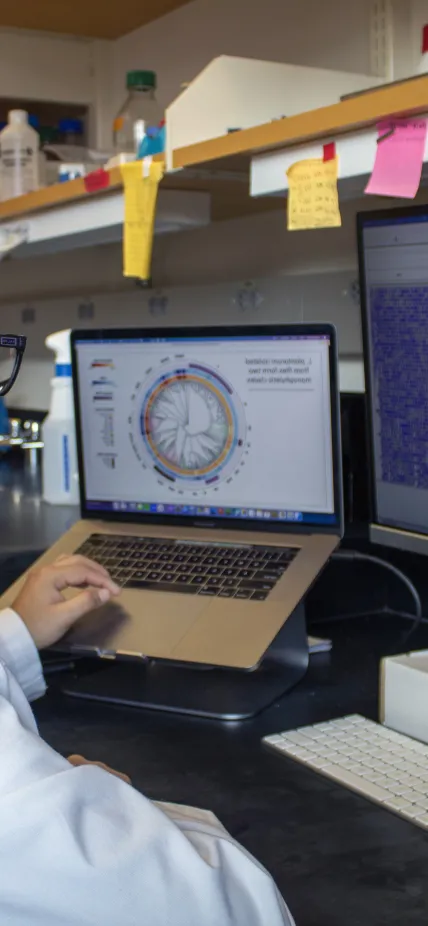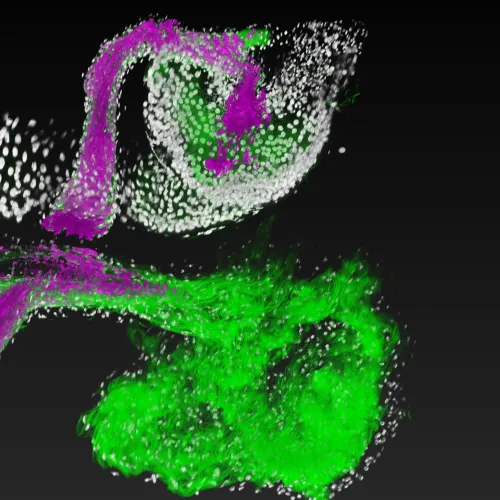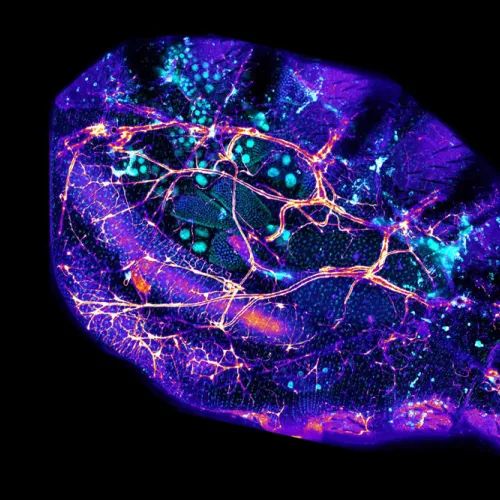Q: What is your general field of study?
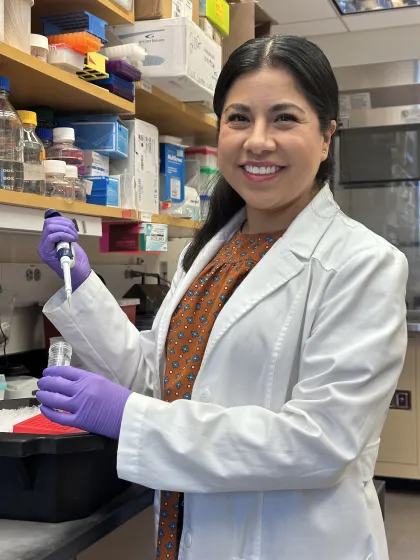
In simple terms, I study the gut microbiome, complex ecosystems of interconnected microbial communities that live in the digestive systems of humans, as well as other mammals and fruit flies. I aim to determine how these microbiomes interact with their host and understand the mechanism that enables beneficial bacteria to adhere to the gut and colonize. We’ve all seen the countless probiotic products that are being marketed as the answer to gut health. However, we don’t even know if these probiotics work. It’s highly probable that rather than sticking to the gut they are just passing through the body—therefore doing nothing to promote gastrointestinal health.
For these bacteria to contribute to gut health, they need to lock into the optimal environment where they can survive, grow, and reproduce. If we can understand how the gut microbiome works, we will be able to engineer probiotics that will adhere to gut tissue and colonize—in essence creating a self-sustaining system.
Q: What is the coolest thing you’ve worked on so far in your career?
Recently, I’ve been working in Will Ludington’s lab at Carnegie Science along with several colleagues studying the probiotic bacteria Lactiplantibacillus plantarum (L. plantarum) in the guts of Drosophila melanogaster, otherwise known as the common fruit fly. Humans have a very complex gut microbiome, with 1,000 or more different bacteria, whereas fruit flies have a similar gut system to humans but a much less complex microbiome, with only five to 10 different bacteria. This makes them the perfect model organism for these studies.
We developed a high-resolution imaging technology that allowed us to track a single cell of L. plantarum in real-time as it colonized a specific region of fruit flies’ guts. Seeing this process in vivo helped us identify the difference between bacteria that were able to adhere to the gut and colonize over the long term versus bacteria whose colonization was more transient. We discovered that bacterial colonization is highly host-specific: only L. plantarum isolated from fruit flies—as opposed to L. plantarum from humans or other organisms—was able to adhere to and colonize a targeted region of the fruit fly gut. We knew that there had to be some genetic basis that facilitated sustained colonization, and so we worked to identify the genes involved in this process. Eventually, we were able to pinpoint key genes that synthesize special proteins called adhesins that are instrumental to symbiotic gut colonization. Our theory is that if we take similar genes from human L. plantarum isolate and introduce them to a non-colonizer bacterium this will drive successful colonization in the human gut. The discovery of these genes is a major breakthrough that will inform how we can eventually create probiotics that are ideally suited to bind to and reproduce in targeted areas of the human gut.
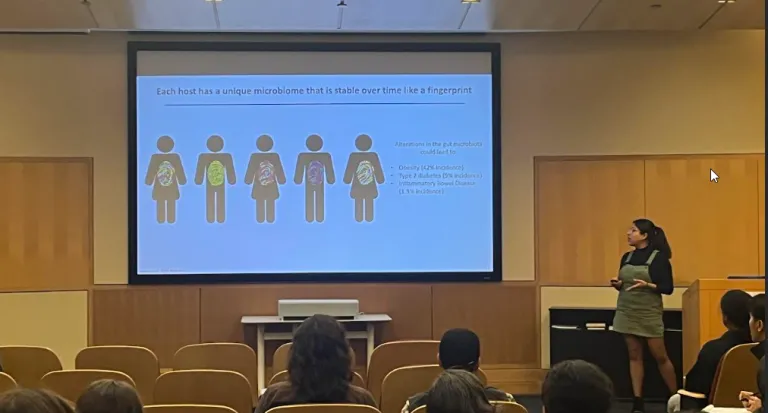
Q: What do you think is the most exciting research direction happening in your field right now?
Two of the most exciting developments in bioengineering at the moment are CRISPR and genome sequencing. These technologies will allow us to modify microorganisms in a specific region of the genome. In this way, we will be able to introduce beneficial genes.
Q: Looking 10 years ahead, what future development do you think will have the greatest impact on your field?
I believe that in the next 10 years molecular biology technologies, combined with sophisticated bioinformatics, and machine learning, will allow us to fully understand how the microbiome works. From there, the ultimate goal is to create synthetic microbe communities, pooling all of the most beneficial microorganisms that will prevent the invasion of pathogenic bacteria into the gut, thereby promoting human health.
Q: Did you always think you would be a scientist? How did you interest in science progress or evolve during your education
I’m a curious person in general, but I have always had a specific interest in human health. From a young age, I was exposed to a lot of human suffering from diseases like diabetes and cancer. When I was 10 years old, my grandmother was diagnosed with diabetes. My parents were working full-time and my sister was really young, so I became her primary caretaker. A nurse, who came once a month to check in on her, explained to me what diabetes was and its treatment—she taught me how to take care of my grandmother. Then in high school, I studied nursing and worked in a hospital.
When it came time to go to college, I realized that I didn’t want to just treat disease—I wanted to get to the root of the problem and help develop cures. So, I decided to go into science instead of nursing or becoming a physician. In undergrad I originally studied Alzheimer’s disease, working with mice in the lab to find a cure. But I hated sacrificing the mice. For my master’s degree, I studied biotechnology and worked in soil bioremediation, removing soil contaminants that cause cancer and genetic diseases. That’s when my interest in bacteria took hold. When it came time for my Ph.D., I decided to keep working with bacteria but I shifted my focus to diabetes with the hope that I could find a way to prevent diabetic complications. I zeroed in on a specific bacteria isolated from a medicinal plant in Mexico called Piper auritum. We found that tea made with the leaves of this plant reduced sugar levels in people suffering from diabetes, but we didn’t know exactly how this worked.

There was the assumption that the plant produced certain compounds that reduced sugar levels. I postulated that it probably wasn’t the plant itself that was lowering sugar levels; I theorized that it was certain bacteria in the plant that created these medicinal compounds. I originally isolated more than 100 bacteria from the plant, but found that the most predominant bacterium was one called Pseudomonas. In my studies of Pseudomonas, I characterized its capacity to produce a specific compound that inhibits the glycation of proteins. People with diabetes have high sugar levels which lead to structural modifications in essential biomolecules—proteins, lipids, and nucleic acids—disrupting their structure and inhibiting their normal functions. Ultimately glycated biomolecules—formally called advanced glycation end products (AGEs)—cause secondary diabetic complications, including skin issues, heart disease, and eye diseases like diabetic retinopathy, macular edema, cataracts, and glaucoma. Most medical literature reports that people with diabetes are more likely to die from the secondary complications of diabetes than the disease itself. So, a main focus of my Ph.D. was trying to identify antiglycation compounds that inhibit the AGEs formation, thereby preventing those diabetic complications. While I loved working with and learning about the function of bacteria in plants, I was also really eager to learn about bacteria in other carrier organisms like humans, mice, and fruit flies, so that I could test different hypotheses about human disease prevention. When I eventually came to Will Ludington’s lab at Carnegie Science as a postdoc, I found the perfect environment where I could work toward preventing human disease by studying more complex organisms like fruit flies.
Q: Was your love of science shaped by a particular experience or mentor?
In undergrad, I was incredibly fortunate to be mentored by a professor named Jose Luis Quintanar-Stephano. He was the head of the neuroscience lab and very supportive. He really encouraged me to continue my pursuit of science—to go for my master’s degree and Ph.D. It’s not common in Mexico for scientists to earn an international Ph.D., but he had earned his in Spain. He was the only PI in the department who had a Ph.D. from outside of Mexico. And so, he urged me to pursue doing science outside of Mexico. He was really instrumental in motivating me and helping me gain confidence. I also admired him because he was a real human being, a good person. He was a great scientist but was also deeply invested in his students and their success. Throughout my trajectory, I also had the privilege of being mentored by a number of other great scientists who helped me evolve and grow as a scientist and a person.
Q: Who is your “Science Superhero?”
I find Marie Curie to be really inspirational. She was a pioneering scientist during a time when there were tremendous challenges for women to have professional careers at all, let alone be a scientist. She persevered through a lot of prejudice and fought to make her mark in a very male-dominated world. And to top it off, she won the Nobel Prize. If she could win two Nobel Prizes under those conditions, it feels like anything is possible.
Q: What are some of the challenges you have encountered so far in your career and how did you address them?

Every day in science is a challenge. What I’ve learned is that you should prepare emotionally and mentally to fail many times before you succeed. One of my biggest challenges is being a Mexican woman in STEM—as a minority, the opportunities are just fewer. For example, I cannot apply for funding from certain national research institutions because I’m not a citizen. Carnegie Science sponsors me, but my ability to work in the United States is contingent upon my job at Carnegie. I can’t work anywhere else. I went to a conference where they were offering funding to minorities from places like Latin America, but to apply you need to be a citizen. The U.S. wants to increase the ranks of minorities in science, but non-citizens are not eligible for funding so it’s very frustrating. Being a woman in science is also very challenging in general. In the science community, people often take men more seriously.
Q: What advice would you give graduate students and others who are just starting their scientific careers?
Always be open to learning and listen carefully. Don’t pretend that you know everything, because nobody knows everything. Also, make an effort to learn from people beyond your circle. As you progress in your career, your circle gets smaller. When you’re an undergrad, you’re surrounded by undergrads. When you are in graduate school, grad students are your circle. Now, my circle consists of other postdocs and PIs. But keep an open mind. You can learn so much from all different kinds of people—even people you’d never imagine. You can learn from undergrads or even people who don’t have degrees in science. Some people are very creative. I met one guy who doesn’t have a major in science, but he is really creative in designing things that help us in our experiments. You can incorporate all different kinds of knowledge in your research. Pursue different perspectives. You often get very deep into your own discipline, and sometimes when you’re that hyper-focused you can lose a broader perspective. Continue to be curious.
Q: Why did you decide to do a postdoctoral position at Carnegie?
Carnegie is a great place to do science. It’s recognized around the world as a highly esteemed organization where many scientists have earned Nobel Prizes—like Barbara McClintock and Albert Hersey, to name just two. I also really like how multi-disciplinary Carnegie is—there are scientists who specialize in plants, microbiologists, molecular biologists, and bioinformaticians. There are so many different kinds of experts you can learn from, and that knowledge can inform your own research.
Q: What has your experience at Carnegie meant to you?
It has been an incredible, beautiful experience. I’ve met two of my best friends here and worked with brilliant colleagues. Carnegie has given me the opportunity to really build on my scientific career, and because it is so multidisciplinary I’ve been able to expand my knowledge in ways I could never have imagined. I’ve also really grown as a human being here. It’s a very supportive, collaborative environment that gives its scientists a great deal of flexibility. They also offer great funding.
Learn More About the Ludington Lab
Could we engineer stability in the microbiome?
VIDEO: A day in the life of the Ludington Lab
